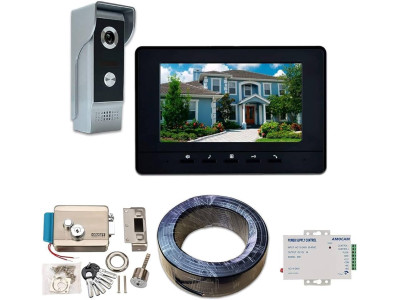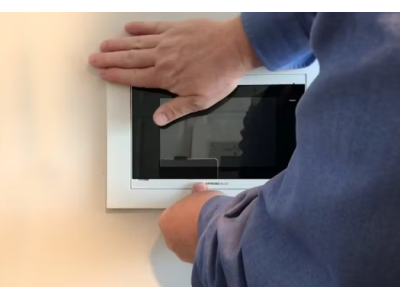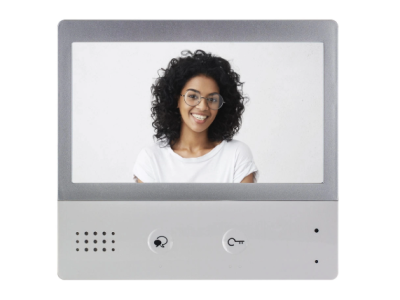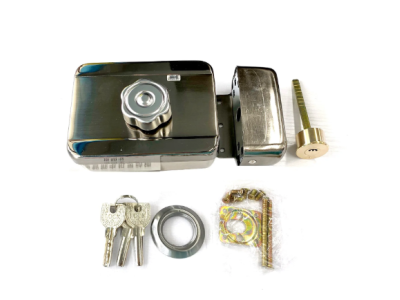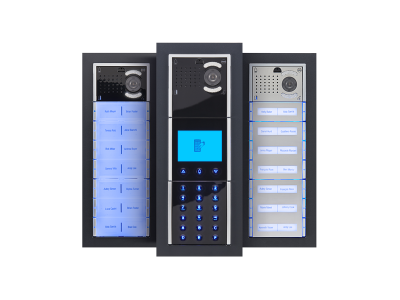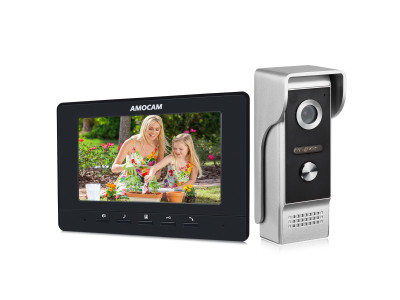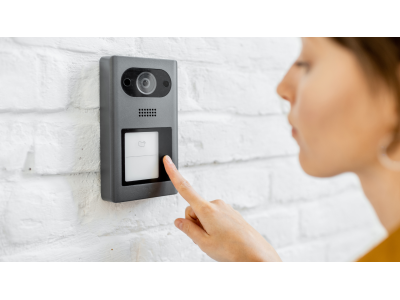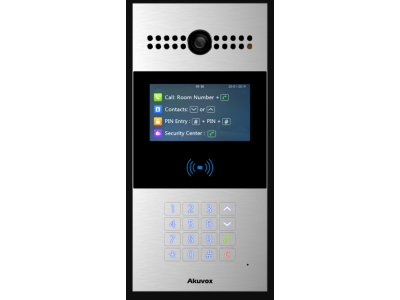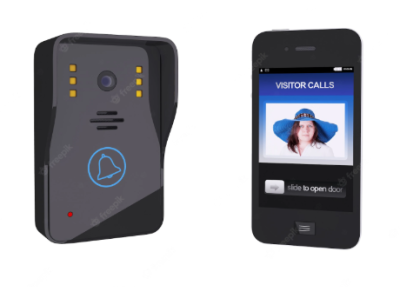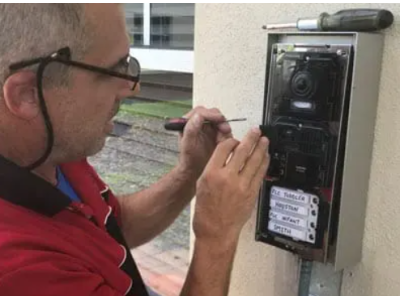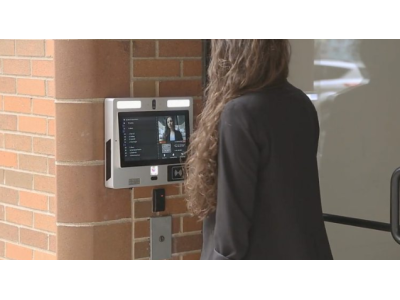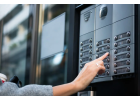
Intercom Systems are multifunctional devices essential for controlling access and enhancing security in residential, commercial, and industrial settings. Modern intercoms offer a wide range of features tailored to various environments, ensuring secure and convenient communication and access management. This guide delves into the principles of intercom operation, classification based on technical and operational parameters, key features, installation processes, and reviews of leading brands to help you make informed decisions for your security needs.
Classification of Intercom Systems
Intercom systems are categorized based on several key parameters that determine their functionality, compatibility, and suitability for different applications. The primary classification criteria include:
Type of Transmitted Information (Audio and/or Video):
- Audio Intercoms: Transmit sound only.
- Video Intercoms: Transmit both audio and video signals.
Communication Interface (Wired/RF or Speakerphone):
- Wired Intercoms: Utilize cables for communication between units.
- Radio-Frequency (RF) Intercoms: Use wireless signals for communication.
- Speakerphone Intercoms: Allow hands-free communication.
Degree of Protection:
- Internal Components: Designed to withstand indoor conditions.
- External Components: Built to resist environmental factors like weather and vandalism.
Number of Supported Users:
- Single-User Intercoms: Designed for individual residences.
- Multi-User Intercoms: Capable of handling multiple users, suitable for apartments and offices.
Construction and Operation Principles (Signal Transmission Method, Digital or Analog):
- Analog Intercoms: Use traditional signal transmission methods.
- Digital Intercoms: Utilize digital signal processing for enhanced functionality.
Functional Capabilities:
- Basic Functions: Call and respond, door release.
- Advanced Functions: Video streaming, remote access, integration with smart home systems.
Basic Configuration, Upgradeability, and Scalability:
- Basic Kits: Include essential components like the main panel and one or two remote units.
- Modular Systems: Allow adding more components as needed.
Types of Locking Devices:
- Electromagnetic Locks: Use magnetic force to secure doors.
- Electromechanical Locks: Combine mechanical locking mechanisms with electronic control.
Options, Parameters, and Characteristics
Number of Users
Intercom systems are categorized based on the number of users they support:
Single-User (Individual) Intercoms:
- Usage: Primarily for single-family homes.
- Features: Simple setup with one main panel and one remote unit.
Small Multi-User Intercoms:
- Usage: Suitable for small apartment buildings, offices, and minor enterprise entrances.
- Features: Multiple call buttons, individual user identification.
Large Multi-User Intercoms:
- Usage: Ideal for high-rise apartment complexes, large office buildings, and extensive commercial facilities.
- Features: Advanced call management, integration with building access systems.
Degree of Protection
Intercom systems must withstand varying environmental and operational conditions:
Internal Units:
- Protection Level: Designed for controlled indoor environments with stable temperatures and minimal physical threats.
- Components: Often housed in protective casings to prevent tampering.
External Units:
- Protection Level: Must resist weather elements (rain, snow, extreme temperatures) and potential vandalism.
- Key Features:
- Protective Canopies: Shield critical components from direct exposure.
- Weatherproof Materials: Use corrosion-resistant metals and sealed enclosures.
- Enhanced Durability: Reinforced casings and tamper-proof screws.
Essential Elements and Parameters for External Units:
- Protective Hood: Covers the speaker, camera lens, and buttons to shield from rain and sunlight.
- Operating Temperature Range: High-quality systems function reliably from -50°C to +50°C, suitable for harsh climates.
- Dust and Moisture Protection: Utilize membranes and rubber/gasket seals to prevent ingress of dust and moisture.
- Vandal-Resistant Construction: Use sturdy materials with minimal seams and secure mounting to deter tampering.
Materials and Technologies
- Diffusers: Prefer latex or rubber-based diffusers for durability and moisture resistance. Avoid paper-based diffusers as they degrade over time.
- Microphones: Electret microphones are recommended over membrane types for better durability and sound quality.
- Housing Materials: Steel is preferred for robustness, while aluminum alloys may require additional protective coverings.
- Anti-Corrosion Coatings: Essential for all metallic parts to prevent rust and degradation.
Vandal Resistance
Intercom units must resist physical attacks and tampering:
- Robust Construction: Use high-strength materials and tamper-proof fasteners.
- Protective Coatings: Ensure surfaces are coated with fire-retardant, non-flammable materials.
- Streamlined Design: Avoid protruding parts that can be easily grabbed or damaged.
Durability
Intercom systems should withstand extensive use and environmental stress:
- Operating Cycles: Quality units should handle up to 1 million button presses, suitable for high-traffic areas.
- Component Quality: Use high-grade electronic and mechanical parts to ensure long-term functionality.
Video or Audio (Type of Transmitted Signal)
The choice between audio and video intercoms depends on security needs and budget:
Audio Intercoms:
- Functionality: Voice communication only.
- Cost: More affordable, suitable for basic access control.
- Limitations: Lack of visual verification.
Video Intercoms:
- Functionality: Voice and video communication.
- Cost: Higher due to additional camera and display components.
- Advantages: Enhanced security through visual identification, remote monitoring capabilities.
Wired vs. Wireless Intercoms
Wired Intercoms:
- Installation: Require cabling between units, suitable for new constructions or renovations.
- Reliability: Generally more stable and secure.
- Maintenance: Less susceptible to interference but more complex to install.
Wireless Intercoms:
- Installation: Easier to install without the need for extensive cabling, ideal for retrofitting existing buildings.
- Reliability: Can be affected by signal interference and distance limitations.
- Features: Often include WiFi or RF-based communication, remote access via smartphones.
Device and Principle of Operation
Operation Principles
Intercom systems operate based on signal transmission between the main panel and remote units:
Coordinate-Matrix (Analog):
- Function: Use physical wiring to connect individual call buttons to specific remote units.
- Advantages: Cost-effective and simple setup.
- Disadvantages: Limited scalability and flexibility.
Digital Intercoms:
- Function: Utilize digital signal processing for improved functionality and scalability.
- Advantages: Enhanced features like video streaming, remote access, and integration with other security systems.
- Disadvantages: Higher cost and complexity.
Wireless Intercoms:
- Function: Use radio frequencies or WiFi to transmit signals between units.
- Advantages: Easy installation without the need for physical cables.
- Disadvantages: Potential for signal interference and security vulnerabilities.
Types of Locking Devices
Intercom systems integrate with various types of locks to control access:
Electromagnetic Locks:
- Mechanism: Utilize an electromagnet and armature plate to secure doors. When powered, the magnet holds the plate firmly, keeping the door closed.
- Advantages: High holding force, simple installation, and maintenance.
- Disadvantages: Automatically unlocks when power is lost, requiring backup power solutions.
Electromechanical Locks:
- Mechanism: Combine traditional mechanical locking with electronic control, allowing for keyless entry and remote access.
- Advantages: Remain locked during power outages, versatile installation options (surface-mounted or recessed).
- Disadvantages: More complex installation and higher cost compared to electromagnetic locks.
Functional Capabilities
Modern intercom systems offer a range of functionalities beyond basic call and entry control:
- Door Release Mechanisms: Enable authorized users to unlock doors remotely or via access devices.
- Access Code Management: Allow programming of unique access codes for different users.
- Event Logging: Maintain records of access attempts and system activities for security monitoring.
- Integration with Surveillance Systems: Combine video intercoms with CCTV cameras for comprehensive security coverage.
- Smartphone Integration: Enable remote control and monitoring through mobile applications.
- Motion Detection: Trigger notifications or automatic unlocking based on movement detection.
Selection Criteria for Intercom Systems
Choosing the right intercom system involves evaluating multiple factors to ensure it meets your security and operational needs:
Number of Users and Subscriber Units:
- Determine the scale of the system based on the number of users and locations requiring access control.
Method of User Identification:
- PIN Codes: Basic level of security, suitable for low-traffic areas.
- Touch Memory Keys: Offer a higher level of security and ease of use.
- Magnetic Cards: Provide secure and convenient access, ideal for commercial environments.
- Biometric Scanners: Highest security level, using fingerprints or facial recognition for access.
Type of Locking Device:
- Electromagnetic: Suitable for environments where fail-safe operation is acceptable.
- Electromechanical: Ideal for high-security areas requiring fail-secure operation.
Operation Features of Door Closers:
- Adjustable Intensity: Control the force exerted by door closers for different usage scenarios.
- Temperature Control: Ensure door closers operate efficiently across various temperature ranges.
Setup and Maintenance:
- Ease of Initial Configuration: Choose systems that offer straightforward setup and user-friendly interfaces.
- Upgrade and Scalability: Ensure the system can be expanded or upgraded as security needs evolve.
Mounting Options:
- Surface-Mounted: Easier to install, suitable for existing doors without modification.
- Recessed: Offers a more integrated and aesthetically pleasing installation, but requires precise placement.
Field of View for Video Intercoms:
- Wide-Angle Cameras: Prevent blind spots and provide comprehensive visual coverage.
- High-Resolution Displays: Ensure clear and detailed video feeds for accurate identification.
Compatibility with External Management Systems:
- Ensure the intercom system can integrate seamlessly with other security systems like alarms and surveillance cameras.
Reputable Brands and Models
Selecting a reliable brand ensures the durability, functionality, and security of your intercom system. Below are some trusted manufacturers and their popular models:
1. Vizit
Overview: A domestic manufacturer offering a comprehensive range of intercom systems, including audio, video, single-user, and multi-user models. Known for budget-friendly and reliable products adapted to harsh climates.
Popular Models:
- Vizit AudioBasic 1: Single-user audio intercom ideal for residential use.
- Vizit VideoPro 10: Multi-user video intercom with high-resolution cameras and robust security features.
2. Cyfral
Overview: One of Russia’s largest producers of access control equipment, offering a wide assortment of intercom systems. Known for digital and video intercoms suitable for large buildings and multi-tenant environments.
Popular Models:
- Cyfral DigitalConnect 50: Digital intercom system supporting up to 50 users, ideal for large apartment complexes.
- Cyfral VideoSecure 100: Advanced video intercom with integration capabilities for extensive security systems.
3. Commax
Overview: A South Korean company with a global presence, providing a diverse range of intercom systems tailored for various environments. Known for high-quality and technologically advanced products.
Popular Models:
- Commax SmartEntry V500: Video intercom with smartphone integration and remote access features.
- Commax AudioConnect A200: Reliable audio intercom with simple installation and user-friendly interface.
4. Kocom
Overview: A South Korean manufacturer producing both audio and video intercoms along with a wide range of accessories. Recognized for high-quality, affordable products suitable for diverse applications.
Popular Models:
- Kocom SecureTalk 300: Audio intercom with robust communication capabilities.
- Kocom VisionPro 700: Video intercom offering clear video feeds and seamless integration with other security systems.
5. Slinex
Overview: A smaller company specializing in premium video intercom systems. Offers a limited range of high-end models with extensive functionality.
Popular Models:
- Slinex PremiumView X1: High-end video intercom with 4K resolution and advanced motion detection.
- Slinex EliteSecure Y2: Top-tier model with integrated surveillance and smart home compatibility.
6. One Touch
Overview: Focuses on elite intercom systems with wireless technology and emphasis on remote management via smartphones.
Popular Models:
- One Touch SmartHome Pro: Wireless video intercom with full smartphone integration and remote control.
- One Touch SecureAccess S3: Advanced model offering biometric access and seamless smart device connectivity.
7. Tantos
Overview: A Canadian company producing simple yet reliable audio and video intercoms at affordable prices. Suitable for domestic and small commercial use.
Popular Models:
- Tantos AudioLink 100: Basic audio intercom system with durable construction.
- Tantos VideoView 200: Cost-effective video intercom with essential features for residential security.
8. Falcon Eye
Overview: A brand under STR INTERNATIONAL, based in Hong Kong with a focus on feature-rich intercom systems, particularly video models. Known for premium functionalities and robust performance.
Popular Models:
- Falcon Eye VisionMaster 400: High-functionality video intercom with extensive integration options.
- Falcon Eye SecureTalk 600: Advanced audio intercom with enhanced security features and durability.
Compliance with Standards and Regulations
Ensuring that your intercom system complies with relevant standards is crucial for safety, reliability, and legal adherence.
Relevant Standards
NFPA 72 – National Fire Alarm and Signaling Code:
- Governs the design, installation, and maintenance of fire alarm and signaling systems, including aspects related to ACS integration.
National Electrical Code (NEC):
- Regulates the electrical aspects of alarm system installations to ensure safety and compliance.
UL Standards:
- Provide safety and performance requirements for security alarm devices and components.
OSHA Standards (29 CFR 1910):
- Include fire safety regulations for workplaces, covering the installation and maintenance of fire alarm systems to protect employees.
Local Building Codes:
- Additional requirements specific to your locality must also be adhered to for compliance and safety.
Key Compliance Points
Power Supply Design:
- Ensure all power supplies meet the electrical requirements outlined in NEC and UL standards, including proper grounding and protection mechanisms.
Cable Management:
- Adhere to guidelines for cable routing, minimizing exposure and protecting against physical damage or tampering.
System Integration:
- Ensure that all ACS components are correctly integrated with other security and safety systems for coordinated operation.
Data Protection:
- Comply with data privacy laws such as the California Consumer Privacy Act (CCPA) to protect biometric and other sensitive data.
Emergency Power Solutions:
- Implement backup power systems (e.g., UPS, batteries) in compliance with NFPA 72 to ensure system functionality during emergencies.
Final Thoughts
Intercom Systems play a pivotal role in modern security infrastructures, providing efficient and reliable means of managing access and communication within various environments. By understanding the different types, key features, installation processes, and adhering to best practices and standards, you can effectively enhance your property’s security. Whether for a private residence, a commercial building, or an industrial facility, selecting the right intercom system tailored to your specific needs ensures robust protection and seamless access management.
Key Takeaways:
Determine Your Needs: Assess the number of users, type of access control required, and the specific security challenges of your property.
Choose the Right Type: Select between audio, video, wired, or wireless intercoms based on your operational requirements and budget.
Ensure Proper Installation: Follow best practices for mounting, wiring, and configuring your intercom system to achieve optimal performance and security.
Implement Backup Power: Use UPS or battery backups to maintain intercom functionality during power outages, ensuring continuous security.
Regular Maintenance: Conduct routine inspections and maintenance to prevent wear and ensure reliable operation of both intercoms and controllers.
Manage Access Effectively: Regularly update access credentials and manage user permissions through the controller to maintain security integrity.
Integrate with Other Security Systems: Combine intercoms with surveillance cameras, alarm systems, and access control systems for comprehensive protection.
Adhere to Standards: Ensure all installations comply with relevant electrical and building codes to guarantee safety and legal compliance.
Secure Wiring Practices: Route cables through concealed pathways and protect them from physical damage and tampering.
Professional Assistance: Consider hiring certified security professionals for installation and maintenance to ensure intercom systems operate effectively and securely.
For expert assistance in selecting and installing intercom systems, ensuring compliance with relevant standards, or accessing comprehensive project documentation, visit safsale.com. Our specialists are ready to help you design and deploy reliable, compliant, and efficient access control solutions tailored to your specific security needs.
Important Notice on Standards
All referenced documents and standards in this guide are provided for informational purposes only and should not be used as official publications. For authoritative guidelines and legal requirements, always consult the official standards organizations or regulatory bodies.
